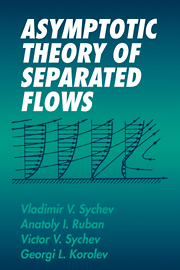Book contents
- Frontmatter
- Contents
- Preface
- Preface to the English Edition
- 1 The Theory of Separation from a Smooth Surface
- 2 Flow Separation from Corners of a Body Contour
- 3 Flow in the Vicinity of the Trailing Edge of a Thin Airfoil
- 4 Separation at the Leading Edge of a Thin Airfoil
- 5 The Theory of Unsteady Separation
- 6 The Asymptotic Theory of Flow Past Blunt Bodies
- 7 Numerical Methods for Solving the Equations of Interaction
- References
- Index
1 - The Theory of Separation from a Smooth Surface
Published online by Cambridge University Press: 07 October 2011
- Frontmatter
- Contents
- Preface
- Preface to the English Edition
- 1 The Theory of Separation from a Smooth Surface
- 2 Flow Separation from Corners of a Body Contour
- 3 Flow in the Vicinity of the Trailing Edge of a Thin Airfoil
- 4 Separation at the Leading Edge of a Thin Airfoil
- 5 The Theory of Unsteady Separation
- 6 The Asymptotic Theory of Flow Past Blunt Bodies
- 7 Numerical Methods for Solving the Equations of Interaction
- References
- Index
Summary
The problem of studying flow separation from the surface of a solid body, and the flow that is developed as a result of this separation, is among the fundamental and most difficult problems of theoretical hydrodynamics. The first attempts at describing separated flow past blunt bodies are known to have been made by Helmholtz (1868) and Kirchhoff (1869) as early as the middle of the nineteenth century, within the framework of the classical theory of ideal fluid flows. Although in the work of Helmholtz one can find some indication of the viscous nature of mixing layers, which are represented in the limit as tangential discontinuities, nonetheless before Prandtl (1904) developed the boundary-layer theory at the beginning of the twentieth century there were no adequate methods for investigating such flows. Prandtl was the first to explain the physical nature of flow separation at high Reynolds number as separation of the boundary layer. In essence, Prandtl's boundary-layer theory proved to be the foundation for all further studies of the asymptotic behavior of either liquid or gas flows with extremely low viscosity, i.e., flows of media similar to air or water, with which one is most commonly concerned in nature and engineering. Therefore we begin with a brief description of the main ideas of this theory.
Boundary-Layer Theory
The Navier–Stokes equations with corresponding boundary and initial conditions are usually used as the basic system of relations describing a viscous fluid flow. These equations reflect sufficiently well the behavior of real liquids and gases.
Information
- Type
- Chapter
- Information
- Asymptotic Theory of Separated Flows , pp. 1 - 34Publisher: Cambridge University PressPrint publication year: 1998
